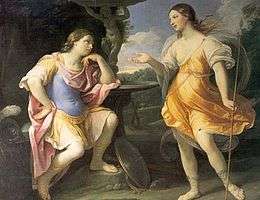Bradamante
| Bradamante | |
|---|---|
.jpg) Bradamante valorosa (1597) by Antonio Tempesta | |
| First appearance | Orlando Innamorato |
| Information | |
| Gender | Female |
| Occupation | Knight |
| Spouse(s) | Ruggiero |
| Relatives | Rinaldo (brother) |
| Religion | Christian |
Bradamante (occasionally spelled Bradamant) is a fictional knight heroine in two epic poems of the Renaissance: Orlando Innamorato by Matteo Maria Boiardo and Orlando Furioso by Ludovico Ariosto.[1] Since the poems exerted a wide influence on later culture, she became a recurring character in Western art.[2][3]
In Orlando Innamorato and Orlando Furioso
Bradamante, a female Christian knight, is the sister of Rinaldo and falls in love with a Saracen warrior named Ruggiero, but refuses to marry him unless he converts from Islam. An expert in combat, she wields a magical lance that unhorses anyone it touches, and rescues Ruggiero from being imprisoned by the wizard Atlante.[4]
The two lovers are separated many times in the story, and her parents reject the suitor even after Ruggiero converts to Christianity, preferring a nobleman called Leo. She decides to marry whoever withstands her in combat and Ruggiero overcomes the challenge.[5] At the end, their marriage give rise to the noble House of Este, who were patrons to both Boiardo and Ariosto.[6][7]
The poems drew from legends of Charlemagne, chansons de geste, and blended recurring motifs found in the Matter of France and the Matter of Britain.[8][9][10]
In later works
In 1582, French dramatist Robert Garnier wrote a tragicomedy named Bradamante that further develops the love story between the heroine and Roger (Ruggiero).[11]
Several eponymous operas have been written about the heroine:

- La Bradamante, written by Pietro Paolo Bissari with music composed by Francesco Cavalli, was first performed in 1650 at the Teatro Santi Giovanni e Paolo of Venice.[12]
- Bradamante, composed by Louis Lacoste with a libretto written by Pierre-Charles Roy, was first performed at the Académie Royale de Musique (the Paris Opera) on 2 May 1707.[13]
- Bradamante, written by Heinrich Joseph von Collin with music composed by Johann Friedrich Reichardt, was first performed in Vienna on 3 February 1809.[13]
- Bradamante, composed by Eduard Tauwitz, was first performed in Riga in 1844.[13]
Bradamante appears as one of the leading characters in several novels. For example, in Italo Calvino's surrealistic, highly ironic 1959 novel Il Cavaliere inesistente (The Nonexistent Knight).[14]
In cinema, she is depicted by Barbara De Rossi in the 1983 Italian film Paladini-storia d'armi e d'amori (also known as Paladins—the story of love and arms or Hearts and Armour) – a film based on the legends surrounding the Peers of Charlemagne.[15]
See also
- List of woman warriors in legend and mythology
 Media related to Bradamante at Wikimedia Commons
Media related to Bradamante at Wikimedia Commons
Notes and references
- ↑ Calvino, Italo (23 October 2012). "Bradamante e Marfisa". Orlando furioso di Ludovico Ariosto raccontato da Italo Calvino [Orlando Furioso by Ludovico Ariosto narrated by Italo Calvino] (in Italian). Segrate, Italy: Edizioni Mondadori. p. 180. ISBN 978-88-520-3018-5. Retrieved 14 July 2016.
- ↑ Shemek, Deanna (1998). Ladies Errant: Wayward Women and Social Order in Early Modern Italy. Durham, NC, USA: Duke University Press. p. 13. ISBN 0-8223-2167-X. Retrieved 15 July 2016.
- ↑ Stoppino, Eleonora (2012). Genealogies of Fiction: Women Warriors and the Dynastic Imagination in the Orlando Furioso. Bronx, New York: Fordham University Press. p. 177. ISBN 978-0-8232-4037-1. Retrieved 15 July 2016.
- ↑ Lang, Andrew (1905). The Red Romance Book. London: Longmans, Green, and Company. p. 345. Retrieved 14 July 2016.
- ↑ Bulfinch, Thomas (1913). The Age of Fable: or Beauties of Mythology. Volume IV: Legends of Charlemagne. New York: Review of Reviews Co. ISBN 1-58734-082-8. Retrieved 14 July 2016.
- ↑ Merriam-Webster, Inc. (1995). Merriam-Webster's Encyclopedia of Literature. Springfield, MA, USA: Merriam-Webster. p. 166. ISBN 978-0-87779-042-6. Retrieved 15 July 2016.
- ↑ Reynolds, Barbara (30 August 1975). "Introduction". In Arisoto, Ludovico. Orlando Furioso: Part I. Translated by Reynolds, Barbara. New York, USA: Penguin Group. p. 64. ISBN 978-1-101-49280-2. Retrieved 15 July 2016.
- ↑ Giardina, Henry (24 June 2014). "Mad with Desire (Kind Of)". Paris Review. Retrieved 15 July 2016.
- ↑ DeSa Wiggins, Peter in Beecher, Donald; Ciavolella, Massimo; Fedi, Roberto (2003). Ariosto Today: Contemporary Perspectives. University of Toronto Press. p. 28. ISBN 0802029671.
- ↑ Ward, Adolphus William; Waller, Alfred Rayney; Trent, William Peterfield; Erskine, John; Sherman, Stuart Pratt; Van Doren, Carl, eds. (1907–1921). "Chapter XIII: Metrical Romances, 1200–1500". The Cambridge History of English and American Literature. Cambridge, U.K.: Cambridge University Press. p. 13. ISBN 1-58734-073-9. Retrieved 14 July 2016.
- ↑ Stone, Donald (2015). "The Place of Garnier's Bradamante in Dramatic History". Journal of the Australasian Universities Language and Literature Association. 26 (1): 260–271. doi:10.1179/aulla.1966.26.1.007. ISSN 0001-2793.
- ↑ Galvani, Livio Niso (Giovanni Salvioli) (1879). I Teatri Musicali di Venezia nel Secolo XVII (1637-1700): Memorie Storiche e Bibliografiche [The Musical Theatre of Venice in the 17th Century (1637-1700): Historical and Bibliographical Memoir] (in Italian). Milan, Italy: Arnaldo Forni Editore. p. 33. Retrieved 15 July 2016.
- 1 2 3 Clément, Félix; Larousse, Pierre (1881). Dictionnaire des Opéras [Dictionary of Operas] (in French). Paris, France: Administration du Grand Dictionnaire Universel. p. 119. Retrieved 15 July 2016.
- ↑ Bloom, Harold (2002). Italo Calvino: Comprehensive Research and Study Guide. Broomall, PA, USA: Chelsea House. p. 82. ISBN 978-0-7910-6824-3. Retrieved 20 July 2016.
- ↑ Beecher, Donald; Ciavolella, Massimo; Fedi, Roberto (2003). Ariosto Today: Contemporary Perspectives. Toronto, Canada: University of Toronto Press. p. 209. ISBN 0802029671.